

The Anatomy of an Amazon 6-pager. A deep dive into writing detailed… The new possible: How HR can help build the organization of the future. Business leaders watching their organizations experience profound upheaval because of the COVID-19 crisis may find it difficult to understand what it all means until the dust settles.

But the pandemic hasn’t afforded them, or any of us, that luxury. It has created profound and immediate changes to how societies operate and how individuals interact and work. We have all witnessed an at-scale shift to remote work, the dynamic reallocation of resources, and the acceleration of digitization and automation to meet changing individual and organizational needs. Organizations have by and large met the challenges of this crisis moment. But as we move toward imagining a postpandemic era, a management system based on old rules—a hierarchy that solves for uniformity, bureaucracy, and control—will no longer be effective. The nine traits of future-ready companies. The ‘Thou Shalt Nots’ of Systems Change. Pace Layering: How Complex Systems Learn and Keep Learning. "Civilizations with long nows look after things better," says Brian Eno.
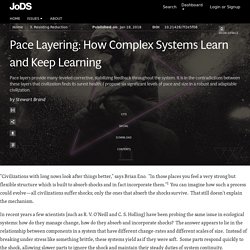
"In those places you feel a very strong but flexible structure which is built to absorb shocks and in fact incorporate them. " You can imagine how such a process could evolve—all civilizations suffer shocks; only the ones that absorb the shocks survive. Beyond matrix organization, the helix organization. The CEO of a major global business, deeply frustrated, took time out recently as a large company-wide reorganization was stumbling toward its conclusion.
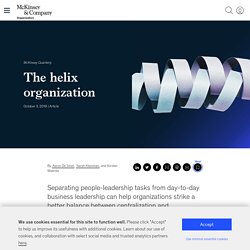
Hard as he and his top team had tried, he told us, attempts to make collaboration and empowerment an enterprise-wide reality were foundering. Although he had been determined to ensure resources were reallocated across the group more dynamically, people and money remained doggedly stuck in slightly revamped silos. Become flexible and speed up with a helix model (part one) July 20, 2020As our business environment becomes more interconnected, we have accepted complexity.

We replicate it through convoluted matrix structures, supported by the same management tools that have been around for decades. These hierarchical charts with solid and dotted-line reporting relationships are complicating organizations, becoming slow and inflexible—the opposite of what’s needed nowadays. Additionally, individual employees are finding themselves reporting to multiple “bosses” making day-to-day tasks a slog. Leaders often reorganize to try and solve the pain points of “efficiency and streamlined, central steering” versus “speed and flexibility with decentral ownership,” creating new pain points.
We are convinced that there is a simple model that can replace matrix structures—designed for stability and dynamism—which will encourage small, ongoing adaptations over full reorganizations. "Nudging": een nieuw en doeltreffend wapen in de strijd tegen wildplassen. Mastering complexity with the consumer-first product portfolio. Consistently combining cost efficiency with consumer value is a challenge many companies spend years trying to get right.
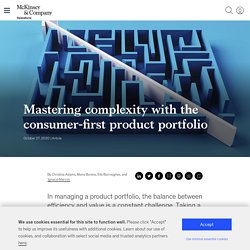
Some take an active stance that too often becomes undisciplined: without a clear governing structure, a siloed approach to innovation and product management results in constant reinvention and multiplying initiatives. At the other extreme are those businesses that do too little with their portfolios, perhaps unsure of the right steps and ending up with a growing tail of low- (or even negative-) margin products—or simply tiptoeing around important design choices in heritage brands. Both approaches typically generate too much complexity in a product portfolio for too little in return. Portfolio optimization was a focus even before pandemic-driven uncertainties took hold, as rapid changes in consumer preferences—along with a transformed retail and competitor landscape—triggered an increasing need for simplification. Six steps to reduce cost and complexity. How to beat the transformation odds. After years of McKinsey research on organizational transformations, the results from our latest McKinsey Global Survey on the topic confirm a long-standing trend: few executives say their companies’ transformations succeed.
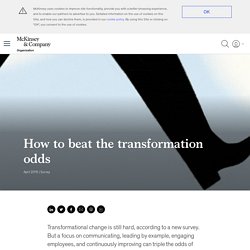
Today, just 26 percent of respondents say the transformations they’re most familiar with have been very or completely successful at both improving performance and equipping the organization to sustain improvements over time. In our 2012 survey, 20 percent of executives said the same. But some companies have beaten the odds. We asked respondents whether their organizations follow 24 specific actions that support five stages of a transformation. At organizations that took a rigorous, action-oriented approach and completed their transformations (that is, all of their initiatives have been fully implemented), executives report a 79 percent success rate—three times the average for all transformations. Meet the Chief Transformation Officer: 8 key tasks for this new role.
How to See "Structure" You have probably already learned about the importance of distinguishing among events, patterns, and structure.

But still, you may be finding it difficult to apply this distinction. Perhaps when you try to analyze an issue from this perspective, the lines between patterns and structure get blurred or you find structure hard to see. Determining the Social and Technical Coordination of Work. Written by Dan Schmitz It has always been a feature of effective organizations that once work activity is divided the work is then re-integrated into a whole system.
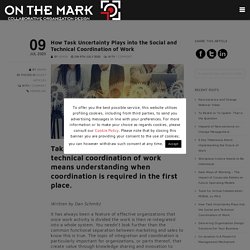
You needn’t look further than the common functional separation between marketing and sales to know this is true. The topic of integration and coordination is particularly important for organizations, or parts thereof, that create value through knowledge sharing and innovation to solve complex issues. An added challenge of our day is the coordination of interdependent but physically dispersed work. SE101: Crash Course on Theory of Change — Innovation for Social Impact Partnership.
Practical lessons on building an agile culture. Around the world, a growing number of organizations are embracing agility to improve delivery, increase speed, and enhance customer and employee experience.
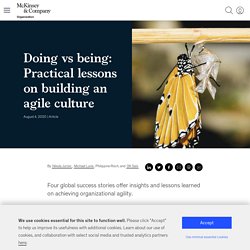
Indeed, in the time of COVID-19, many organizations have accelerated their shift to agile. Our recent research found that agile organizations responded faster to the crisis, while those that do not embrace agile working may well forfeit the benefits of speed and resilience needed in the “next normal” after the COVID-19 pandemic. In essence, agility at an enterprise level means moving strategy, structure, processes, people, and technology toward a new operating model by rebuilding an organization around hundreds of self-steering, high-performing teams supported by a stable backbone. On starting an agile transformation, many organizations emphasize and discuss tribes, squads, chapters, scrums, and DevOps pipelines.
Reimagining the post-pandemic organization. It’s said that the worst of times brings out the best in people; as it happens, this is true of organizations as well.
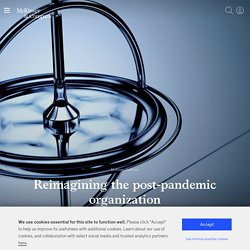
All over the world, companies are being challenged by the COVID-19 crisis to find new ways to serve their customers and communities. Many are rising to the occasion. Almost every leader we speak with has an inspiring story of radical, positive change in how work gets done and what it can accomplish. Here are a few examples: Organisation Models: a Reasoned List between Old and New. Recent years have seen an increased number of Organisation Models appearing on the scene of management. This was primarily in response to the accelerated rhythm of change imposed by the VUCA world and often have come as the result of a crisis of an organisation. We have already encountered a few of these models around, and particularly the recently reviewed Corporate Rebels book (Minnaar and de Morree, 2020) highlights a few of these models and their success in some organisations. With this post, I want to try to build an overview of the suggested models, which I will maintain over time as additional readings and sources of inspiration appears.
Before digging deep, however, I wanted to stress one important fact. To weather a crisis, build a network of teams. This article is part of a series Leadership in a crisis: Responding to the coronavirus outbreak and future challenges. The platform play: How to operate like a tech company. “The question is not how fast tech companies will become car companies, but how fast we will become a tech company.” Insurance ecosystems and platforms: How insurers can turn vision into reality. It is no longer news that digital technologies are reshaping customer expectations and redefining industry boundaries.
Talks Talent: The new science of talent, from roles to returns. How companies are reskilling to address skill gaps. As technologies and business models continue their rapid evolution, companies are experiencing a step change in the workforce skills they need to thrive and grow. Previous research has shown that as many as 375 million workers globally might have to change occupations in the next decade to meet companies’ needs and that automation could free employees to spend as much as 30 percent of their time on new work. Carousel - GlobalGEA. How can we redesign financial services for good? Next-stage Organization. In the Ecosystem Economy, What’s Your Strategy?
When Nestlé was preparing to go mainstream with Nespresso, its single-use espresso capsule, it knew that users would need a machine specifically designed to work with the pod. Beyond matrix organization, the helix organization. 8 Organizational Metaphors - NOBL Academy. A metaphor is a connection. It’s a piece of string coupling two ideas. One idea is usually complex and hard to convey. Transform the whole business, not just parts. How smart platforms can crack the complexity challenge in project industries. Modularization excels in high-volume industries such as automotive, but does it offer tangible benefits for companies that tackle just a few, extremely complicated projects each year?
The builders of steel plants, chemical plants, paper mills, wind parks, packaging lines, or power plants fall into this category, completing a handful of highly specialized solutions every year that feature very specialized components. New research—laid out in our report Smart platforms: Cracking the complexity challenge of project industries—affirms that, if done right, a modular platform strategy can deliver significant value quickly in these situations to fix the complexity challenge. In industries focused on large projects, companies typically face four key challenges: customization at low prices, delays and cost overruns, long payback times due to low volumes, and flexibility between customers and suppliers.
We strive to provide individuals with disabilities equal access to our website. The Self-Tuning Enterprise. Company of the Future. The Self Tuning Enterprise. The forgotten step in leading large-scale change. Company of the Future. The helix organization. Agile is Dead. The global case for customer experience in government. 8 Organizational Metaphors - NOBL Academy. The change management mind-set: Getting personal. Building agile capabilities to drive business transformation. Getting the workplace of the future right. The five frames of performance and health. The essential components of a successful learning and development strategy - pbailleur - Mail van livingsystemscoaching.be. Repositioning as an agile manager.
The journey to an agile organization. Three keys to better decision making. Agile performance management. What are the most important organizational health practices? Habits of a systems thinker – Naomi Stanford. The Emerging Art of Ecosystem Management. The irrational side of change management. Winning the ’20s: The Organization of the Future – BCG Henderson Institute. The Emerging Art of Ecosystem Management. Silosmashing – Naomi Stanford. Global trends: Navigating a world of disruption. Succeeding in the US retail industry in an era of unprecedented disruption. How a U.S. Health Care System Uses 15-Minute Huddles to Keep 23 Hospitals Aligned. Implementation – Scaled Agile Framework. Quantifying the semiconductor supply chain.
Boosting Performance Through Organization Design. How to create an agile organization. Zelfsturing. What is Organizational Design? — NOBL Collective. How does one build an agile organization? And what part does HR need to fill? When Small Ideas Add Up to Something Big. Elements of a successful government transformation. Skill shift: Automation and the future of the workforce.
Sector Automation. Where machines could replace humans. Matrix structures: the pessimism advantage – Naomi Stanford. How the public sector can remain agile beyond times of crisis. The journey to an agile organization at Zalando. Organization design: a toolkit of toolkits – Naomi Stanford. How to mess up your agile transformation in seven easy (mis)steps. How to create an agile organization. Activate agility: the five avenues to success. The five trademarks of agile organizations. Company organization in the age of urgency. Insurance beyond digital: The rise of ecosystems and platforms. Accelerating the shift to a next-generation operating model. What the future of work will mean for jobs, skills, and wages. Articl12. Do you have the right leaders for your growth strategies? Same lean song, different transformation tempo. Defining Strategic Management and Strategy. Witnessing Immoral Acts Makes Us Want to Buy Popular Brands.
Model Baarda - Bureau Baarda. Boosting Performance Through Organization Design. Organizational health: A fast track to performance improvement. Getting Reorgs Right. IT’s future value proposition. The CEO’s guide to competing through HR. The Command and Control Model is Outdated, Even The Military Says So! Neuralink and the Brain's Magical Future. Who should pay for support functions? Design Your Employee Experience as Thoughtfully as You Design Your Customer Experience. Kathryn Schulz: On being wrong. Style that’s sustainable: A new fast-fashion formula. The Hive is the New Network.